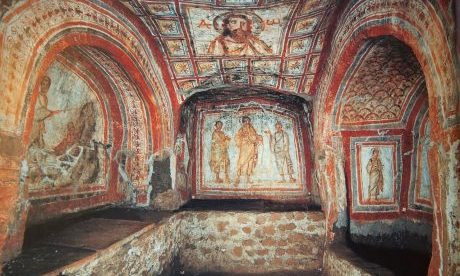ROME – When most people think of Rome they picture the majestic Colosseum or the countless churches and basilicas sprawled across the city, but deep underground there is another Eternal City that tells the tale of the first pioneers of the Christian faith.
The Catacombs of Domitilla, a vast web of tunnels and tombs used by early Christians for refuge and burial, is finding new life under the muck and mold thanks to restorations sponsored by the Pontifical Commission for Sacred Art, which completed its work May 29 and will open the painted crypts to the public next month.
The catacombs “represent the concrete and legible testimony of ‘Christian death,’ seen by our early brothers as a provisory death in anticipation of the final Resurrection,” said Fabrizio Visconti, superintendent at the Commission, at the unveiling May 30.
The United States is usually called the home of pioneers, from its Westward expansion to its race to the Moon, but Italians also have an extraordinary lineup of explorers such as Marco Polo, Amerigo Vespucci, and Christopher Columbus.
Less than a year after Columbus made his voyage to the New World, Antonio Bosio, a Maltese archeologist obsessed with early Christian history, began his exploration of an old World buried under the city of Rome.
In 1593 Bosio first entered the Catacombs of Domitilla, under the patronage of the Order of Malta, earning the title of the “Christopher Columbus of Rome’s underground.”
Like Columbus, Bosio got lost and resorted to the mythological trick of using a ball of thread to trace his steps in the dark labyrinth.
The Catacombs extended for more than 7.4 miles, with two and sometimes four underground floors with a total of 26,250 tombs.
The “city under the city” first started with the Ancient Roman tombs of the first century B.C. that multiplied during the second and third centuries after Christ, when it became a popular Christian burial ground. Continue reading
Sources
Additional readingNews category: Features.




